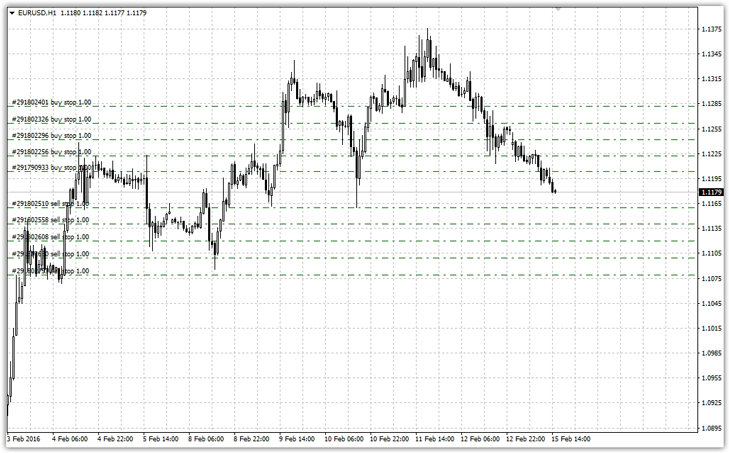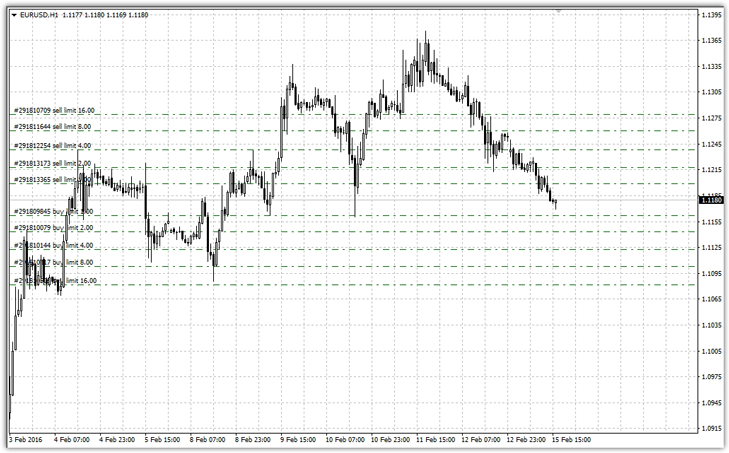Pyramid of pending orders.
There are different approaches to making certain trading decisions. As a rule, among traders, any strategy is usually divided into indicator ones, which are based on one or another combination of indicators, and also non-indicator ones.
As a rule, among traders, any strategy is usually divided into indicator ones, which are based on one or another combination of indicators, and also non-indicator ones.
Without indicators, they are built on the principle of patterns of price behavior, various candlestick patterns and graphic figures.
However, there is another type of strategy that does not even try to show us the entry point into the market or predict the further behavior of the price, and all trading comes down to opening a grid of orders in both directions, so that, regardless of where the price goes, try to take as much profit as possible.
In the professional language, such traders are also called “griders”, but the method itself is makeshift.
Basic principles of the pending order pyramid.
Any network is built on the basis of two types of pending orders, namely stop limit orders. As you probably already know, stop pending orders are executed as the trend moves, while limit orders, on the contrary, resemble counter-trend trading, because they are triggered to buy when the price falls, and to sell when the price rises.
This is where the cardinal difference between the two types of grids comes from, because if in the first option there is a full-fledged following of the price, then in the second option we try to buy at a cheaper price and sell at a higher price. So, having dealt with the main types of networks, we smoothly move on to the principles of construction.
In order to correctly build a network, it is necessary to select a certain distance in points as a constant, which will not change under any market conditions when building the network. The choice of distance between pending orders depends on the characteristics of the currency pair, and the more often flat movements occur, the more the size of the distance between orders expands in order to avoid unnecessary two-sided openings.
So, for example, we choose the size between orders to be 20 points as a constant. Therefore, we need to build a network of pending orders that will be located below and above the price. At a distance of 20 points from the price, two pending orders are opened, a buy stop on top and a sell stop on the bottom.
Next, we need to expand our network by adding four pending orders above and below at a distance of 20 points above and below the valuable one. An example can be seen below:
 After we have built the network, all that remains is to wait in which direction the price will go and wherever it goes in the course of the price movement, a series of orders will be opened. However, trading does not end with the placement of a network of pending orders, and as the price moves in any direction, pending orders should be placed according to a predetermined constant.
After we have built the network, all that remains is to wait in which direction the price will go and wherever it goes in the course of the price movement, a series of orders will be opened. However, trading does not end with the placement of a network of pending orders, and as the price moves in any direction, pending orders should be placed according to a predetermined constant.
So, for example, if a pending buy stop order is triggered and a valuable 40 points pass, you must pull up sell stop orders from below at a distance of 20 points from each other and the price. Profit in such grids with a standard lot is set by the size of a predetermined constant, namely in our case 20 points.
Pyramid of pending orders
If when building a network of stop pending orders one often resorts to a static lot for all orders, then with limit ones it is customary to build a pyramid of pending orders. As we have already said when working with limit orders, buying occurs when the price falls, and selling occurs when it rises.
Therefore, very often the price, when opening an order, can continue its path further, and during a long fall in the grid, you will open a series of purchases. To reduce risks and, due to averaging, exit the market with a profit, each subsequent grid order doubles in volume and thus, at the slightest rollback, it is completely closed.
 Unlike working with a static lot, a trader, as a rule, waits for the total profitable profit and closes the entire grid upon achieving a given goal, after which construction occurs again.
Unlike working with a static lot, a trader, as a rule, waits for the total profitable profit and closes the entire grid upon achieving a given goal, after which construction occurs again.
Using a pyramid of pending orders, or working on a grid principle with a static lot, you must be clearly aware that you will have to be in the market almost all the time. It is for such obvious and banal reasons that you can increasingly see advisors based on grid trading, rather than traders practicing it manually.
